

The database contains physical properties of pipe and element materials. This database can be edited.
To export the database to rtf, press "Export"; to print, press "Print".
If "Add" and "Save" buttons are not available, the file is closed for editing or stress measurement units are not MPa.
When working with START-PROF, it must be noted that the database is for information only and is open for editing. You should thoroughly familiarize yourself with the contents of the database and enter any necessary changes: add required materials, properties, etc.
Stresses are stored in internal units. It is MPa for all codes except ASME. For ASME codes it is ksi. When you edit the database in other units, all values are converted automatically into internal units. This may cause the rounding errors. It is recommended to use ksi (for ASME) and MPa for other codes to avoid rounding errors.
During analysis, if temperature is less than the minimum in the materials database, the material's physical-mechanical properties are taken according to the minimum temperature in the database (usually 20°С).
To export a material from the database, click "export" in the "materials" window and select the ".mat" file path. A saved file can be loaded into the database by clicking "import".
Button "Copy to" may be used to copy material from one code database into another code database. After copying the new material properties should be checked manually, because some of columns may remain blank.
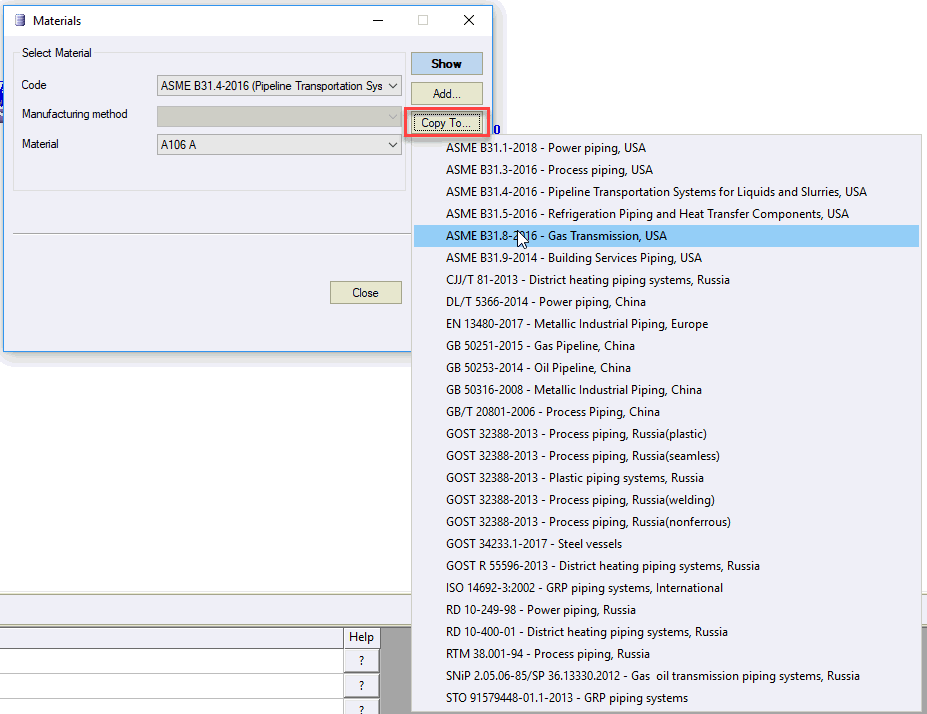
Material properties used in the analysis are saved in a "ctp" file. When a file containing materials not present in the database is opened, you will be asked if you would like to add these materials to the database. If the materials or soils are already present in the database but have different properties, you will be given 3 choices: update the material properties in the database, add the material to the database under a new name, or delete the material from the analysis file and use the database data.
In order to save the new materials when reinstalling START-PROF or installing a new version, there are three options:
1) save the sqlite3 files and put them back into the database folder after installation (usually C:\Program Files (x86)\Common Files\STARTPR\Base). But there is a risk that new versions or releases will not be able to work with old database files
2) save all new materials to mat files one by one ("Export" button)
3) create a START-PROF project file in which to specify pipes from all new materials that you want to save. And then after installing the new version, just open this file and import materials from it into the database of the new version
Contents:
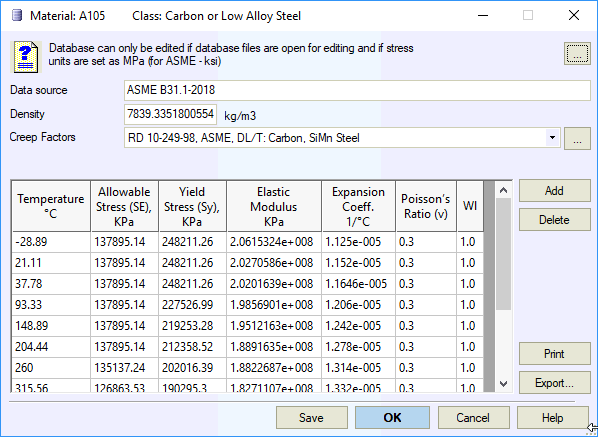
Allowable stresses are stored in "ksi" units.
Data taken from ASME B31.1 code.
Allowable stresses in database (SE) already multiplied by weld joint efficiency factor E (table 102.4.3).
Wl - Weld strength reduction factor (table 102.4.7). Start automatically use this factor for wall thickness check and for allowable stress calculation for circumferential welds (Wc).
Creep Factors are taken from RD 10-249-98.
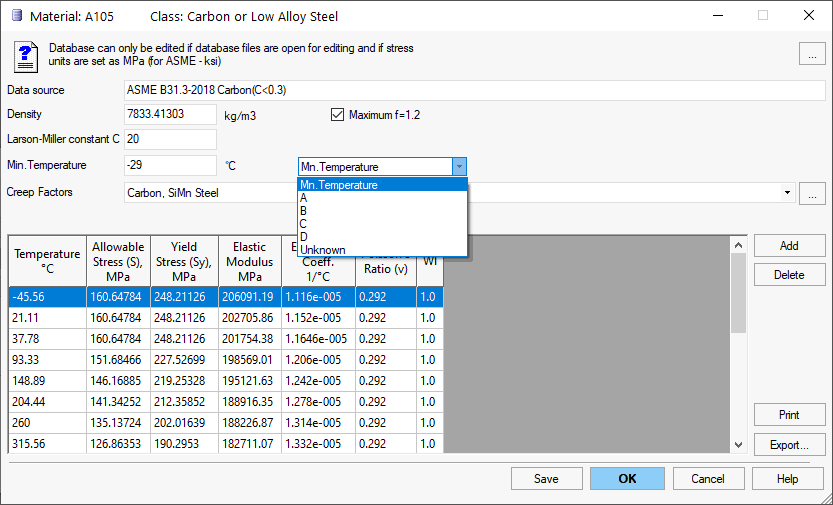
Allowable stresses are stored in "ksi" units.
Data taken from ASME B31.3 code.
Allowable stresses in database (S) are not multiplied by weld joint efficiency factor E (table 302.3.3).
Wl - Weld strength reduction factor (table 302.3.5). Start automatically use this factor for wall thickness check and for allowable stress calculation for circumferential welds (Wc).
Larson-Miller constant "C", according to appendix V

Min.temperature - Used for Minimum Design Metal Temperature (MDMT) calculation according to 323.2.2 of ASME B31.3
A, B, C, D - curve number fig. 323.2.2A
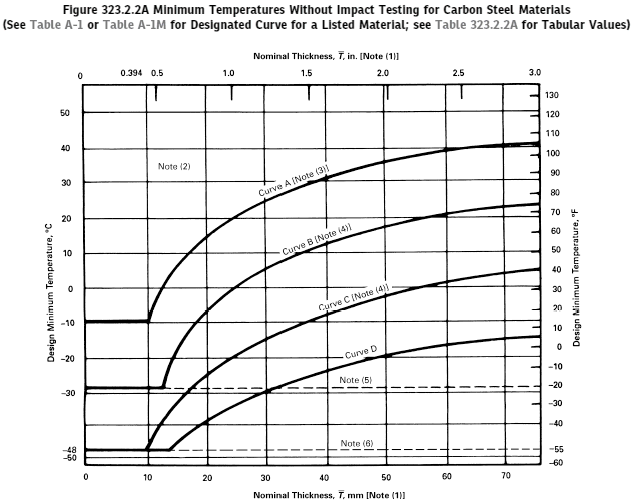
Creep Factors are taken from RD 10-249-98.
Enabled option "Maximum f=1.2" means that stress range factor may be used f=1.2 for this material.


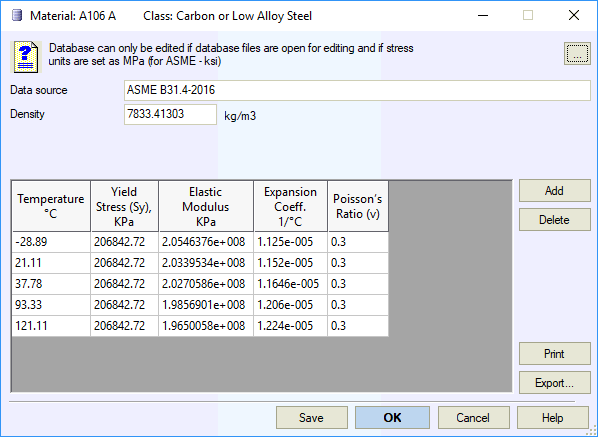
Allowable stresses are stored in "ksi" units.
Data taken from ASME B31.4 code.
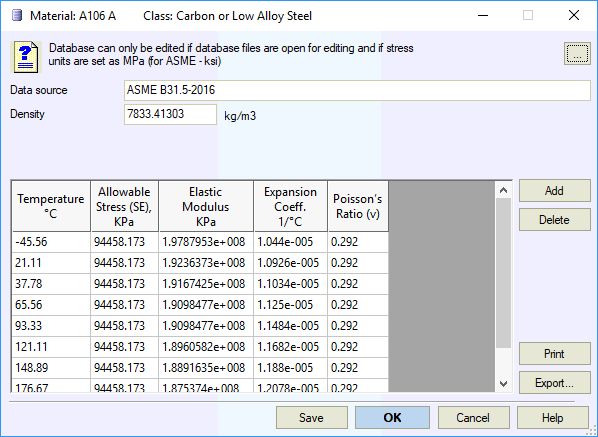
Allowable stresses are stored in "ksi" units.
Data taken from ASME B31.5 code.
Allowable stresses in database (SE) already multiplied by longitudinal or spiral weld joint factor E (table 502.2.1).
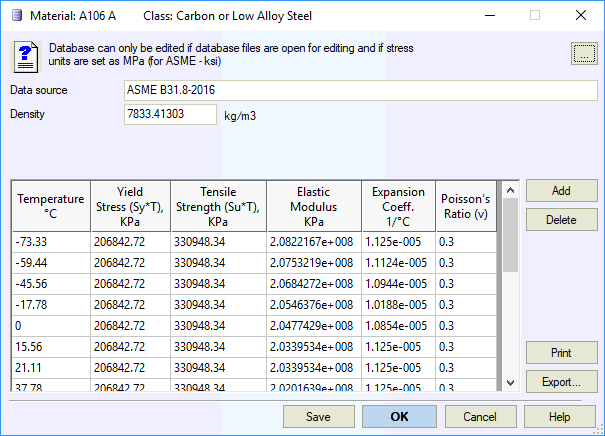
Allowable stresses are stored in "ksi" units.
Data taken from ASME B31.8 code.
Yield Stress (Sy) and Tensile stress (Su) are already multiplied by temperature derating factor "T" (Table 841.1.8-1) in database (Sy*T, Su*T), and not multiplied by longitudinal weld joint factor E (Table 841.1.7-1).
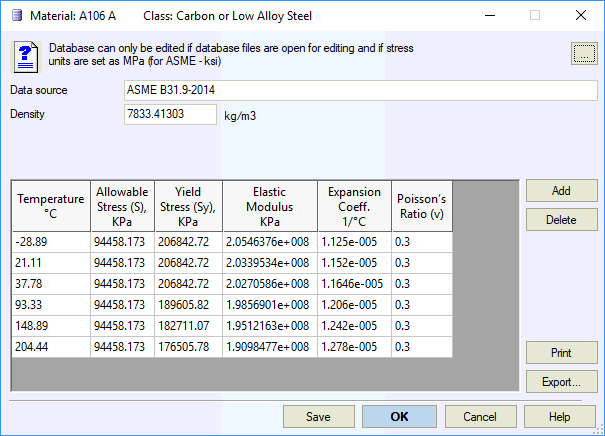
Allowable stresses are stored in "ksi" units.
Data taken from ASME B31.9 code.
Allowable stresses in database (S) are not multiplied by weld joint efficiency factor E.
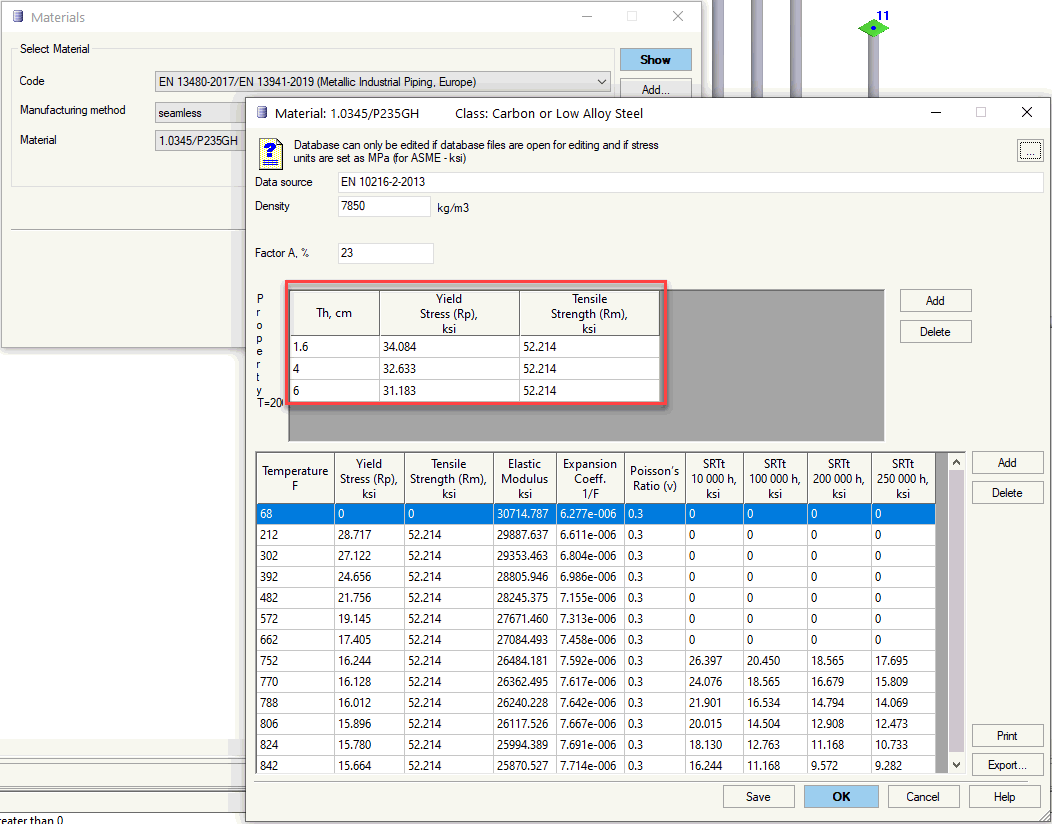
Allowable stresses are stored in "MPa" units.
Data taken from EN 10216-2-2013, EN 10216-5-2013, EN 10217-7-2014 codes.
SRTt - mean value of creep rupture strength for the considered lifetime in hours.
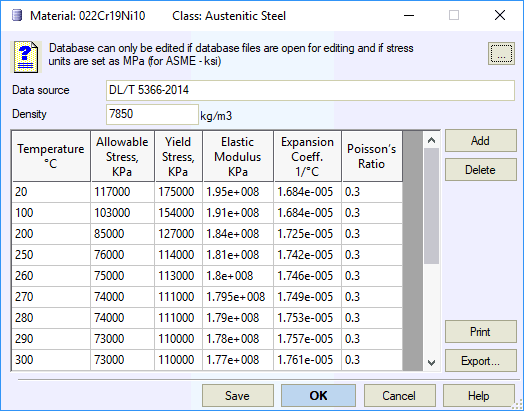
Allowable stresses are stored in "MPa" units.
Data taken from DL/T 5366-2014 code.
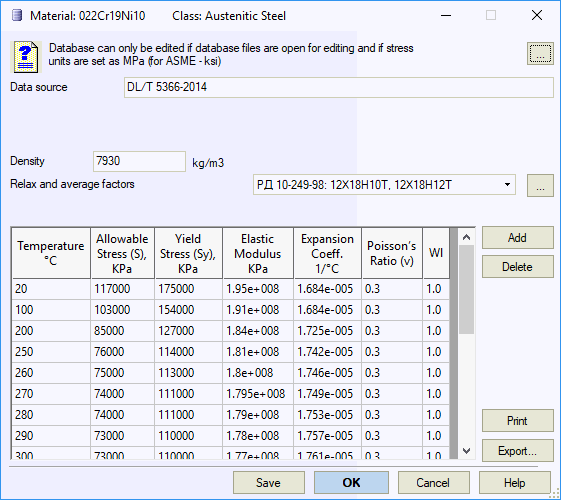
Allowable stresses are stored in "MPa" units.
Data taken from DL/T 5366-2014 code.
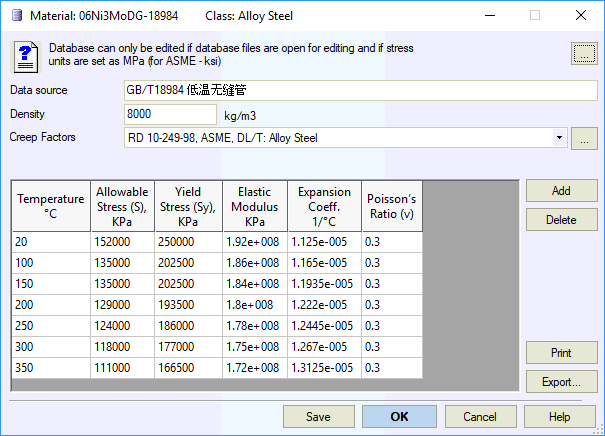
Allowable stresses are stored in "MPa" units.
Allowable stresses in database (S) are not multiplied by weld joint efficiency factor E (table 3).
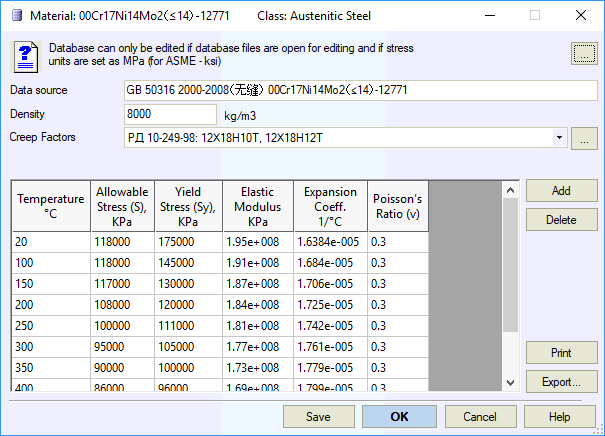
Allowable stresses are stored in "MPa" units.
Data taken from GB 50316-2008 code.
Allowable stresses in database (S) are not multiplied by weld joint efficiency factor E (table 3.2.5).
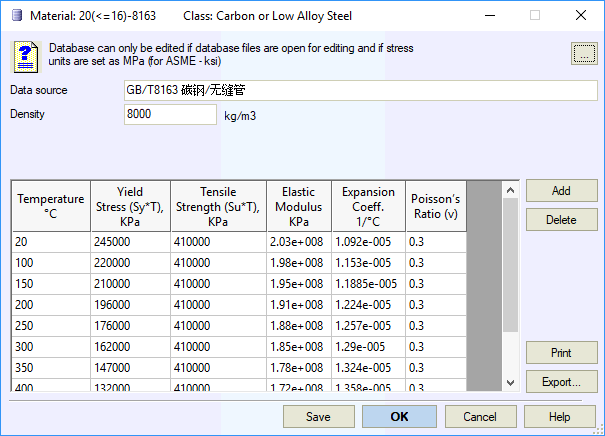
Allowable stresses are stored in "MPa" units.
Yield Stress (Sy) and Tensile stress (Su) are already multiplied by temperature derating factor "T" in database (Sy*T, Su*T), and not multiplied by longitudinal weld joint factor E.
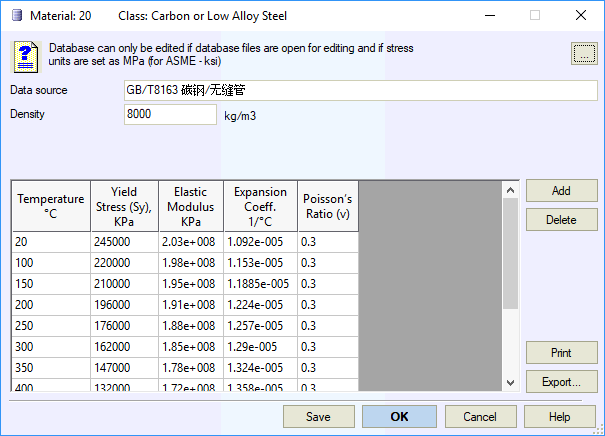
Allowable stresses are stored in "MPa" units.
Allowable stresses are stored in "MPa" units.
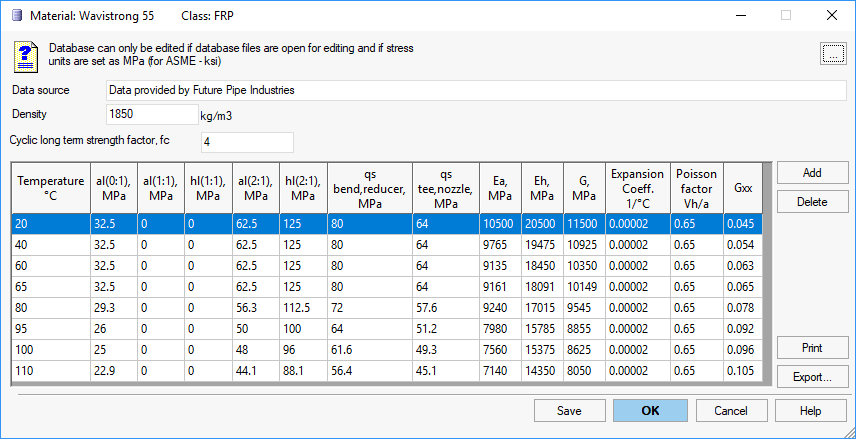
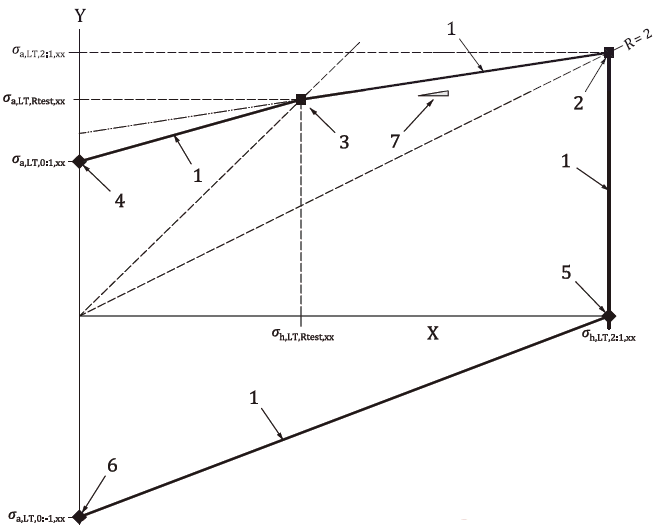
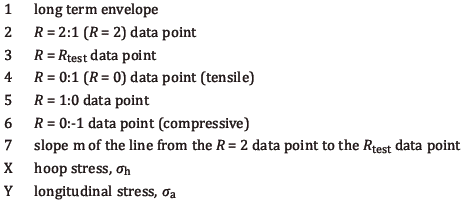
 ,
,  ,
,  ,
,  ,
,
 - long-term failure envelope stress values for
pipes and joints (see picture above), multiplied by the corresponding
factor
- long-term failure envelope stress values for
pipes and joints (see picture above), multiplied by the corresponding
factor  (considering temperature influence). Long-term failure envelope stress calculated
according to Annex B,С ISO 14692-2:2017.
Two types of tests should be performed to determine all necessary
data - see Annex C ISO
14692-2:2017.
(considering temperature influence). Long-term failure envelope stress calculated
according to Annex B,С ISO 14692-2:2017.
Two types of tests should be performed to determine all necessary
data - see Annex C ISO
14692-2:2017.
Points (5) R=1:0 and (6) R=0:-1 no need to specify. It calculated according to code B.2.5, B.2.6 ISO 14692-2:2017.
Point (4) R=0:1 - hoop to axial stress ratio 0:1, i.e. pipe tension under zero pressure. ah(0:1)=0, al(0:1)=Sa,LT,0:1,xx. See B.2.4 ISO 14692-2:2017
Point (3) R=1:1 - hoop to axial stress ratio 1:1, i.e. partially restrained pipe under internal pressure. ah(1:1)=Sh,LT,Rtest,xx, al(1:1)=Sa,LT,Rtest,xx. See B.2.3 ISO 14692-2:2017
Point (2) R=2:1 - hoop to axial stress ratio 2:1, i.e. unrestrained pipe under internal pressure. ah(2:1)=Sh,LT,2:1,xx, al(2:1)=Sa,LT,2:1,xx. See B.2.2 ISO 14692-2:2017
for
bends and reducers: "qs
bend,reducer" qualified stress  , multiplied
by the corresponding temperature factor
, multiplied
by the corresponding temperature factor  . Used
only for ISO 14692-3:2002, for
ISO 14692-2:2017 not used
. Used
only for ISO 14692-3:2002, for
ISO 14692-2:2017 not used
for
tees, nozzles and saddles:
"qs tee, nozzle" qualified stress  ,
multiplied by the corresponding temperature factor
,
multiplied by the corresponding temperature factor  .
Used only for ISO 14692-3:2002,
for ISO 14692-2:2017 not used
.
Used only for ISO 14692-3:2002,
for ISO 14692-2:2017 not used
elasticity
modulus - axial  ,
hoop
,
hoop  and lateral
G, all multiplied
by the corresponding temperature factor
and lateral
G, all multiplied
by the corresponding temperature factor 
linear
expansion factor  and
axial Poisson's ratio
and
axial Poisson's ratio  (Vh/a)
(Vh/a)
Gxx is the gradient of regression at temperature, 6.1.1 ISO 14692-3:2017
fc is the cyclic long term strength factor, A.2 ISO 14692-3:2017
All properties must be input according to data provided by pipe and fiberglass manufacturers
Used only for Start-Elements for piping to equipment stub-in node analysis
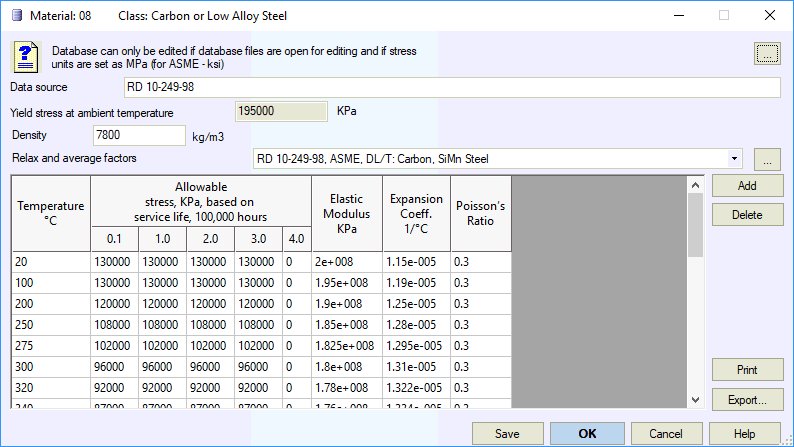
Allowable stresses are stored in "MPa" units.
Tables for each steel contain data
on nominal allowable stress [σ], elasticity
modulus E, linear (thermal)
expansion factor α and Poisson's ratio μ depending on operation temperature and design service
life. All data adapted from
RD 10-249-98. Yield strength at 20°  is used for test pressure stress analysis
(see "wall thickness analysis").
is used for test pressure stress analysis
(see "wall thickness analysis").
When analyzing with RD 10-249-98 allowable stress is interpolated depending on service life in hours. 1 year = 365*24 = 8760 hours.
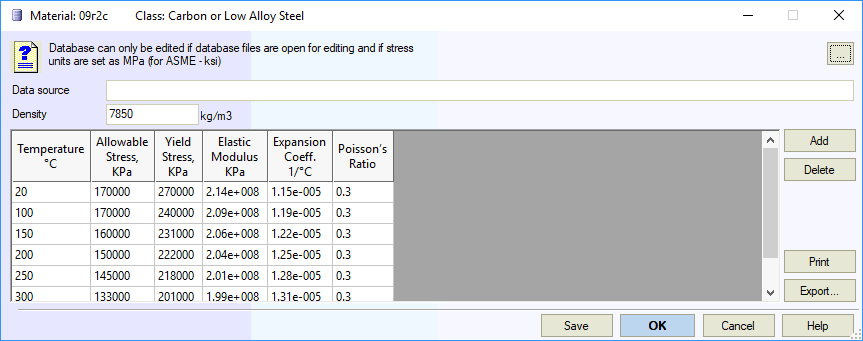
Allowable stresses are stored in "MPa" units.
According to RD 10-400-01 section 3.1, data are adapted from RD 10-249-98, but only for steel used in heating networks up to 350° operation temperature. Yield strength at 20° is used for test pressure stress analysis (see "wall thickness analysis"). Yield strength values are also used for fatigue strength analysis according to RD 10-400-01
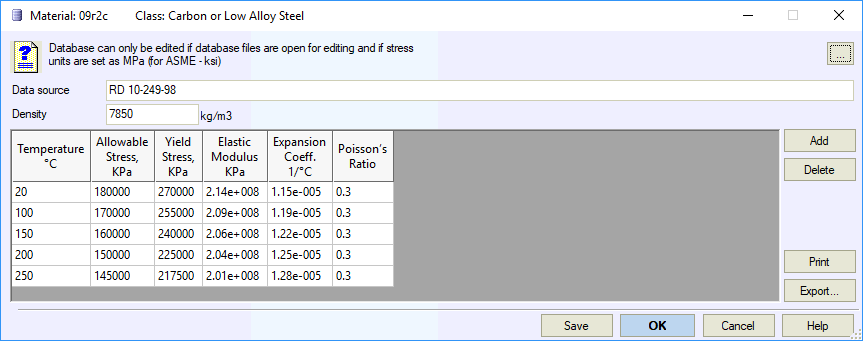
Allowable stresses are stored in "MPa" units.
Data adapted from GOST R 55596-2013
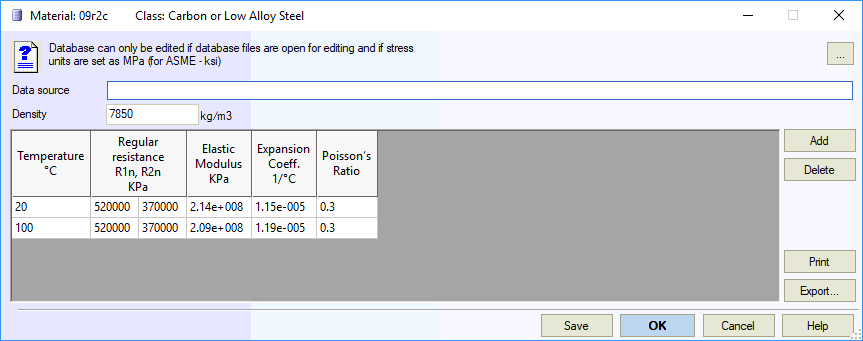
Allowable stresses are stored in "MPa" units.
Standard
resistance to expansion (compression) of pipe and welded joint material,
equal to tensile strength  and yield strength
and yield strength  ,
elasticity
modulus E, linear
expansion factor α
and
Poisson's ratio μ depending on operation temperature.
Must be set according to regional standards and pipe technical properties.
,
elasticity
modulus E, linear
expansion factor α
and
Poisson's ratio μ depending on operation temperature.
Must be set according to regional standards and pipe technical properties.
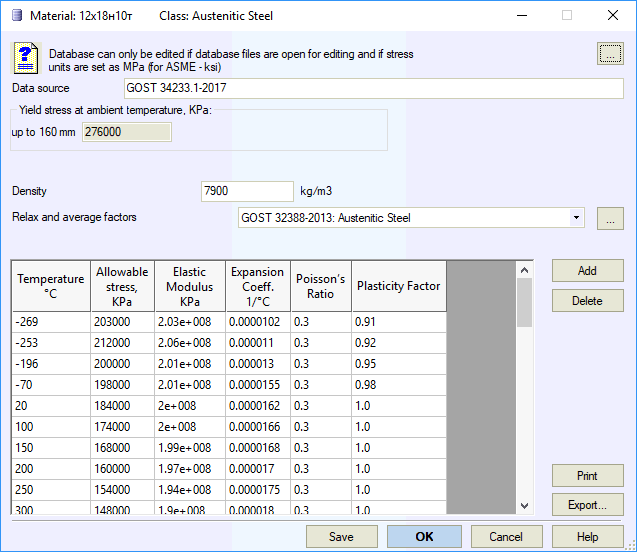
Allowable stresses are stored in "MPa" units.
For seamless pipes, data adapted
from RD 10-249-98
at design service life of 200
thousand hours; for welded pipes,
from GOST 34233.1-2017
[1]. Yield
strength at 20°  is used for test pressure stress analysis
(see "wall thickness
analysis").
is used for test pressure stress analysis
(see "wall thickness
analysis").
Plasticity factor is used for cryogenic piping analysis (with temperatures below 70 degrees Celsius)
Allowable stresses are stored in "MPa" units.
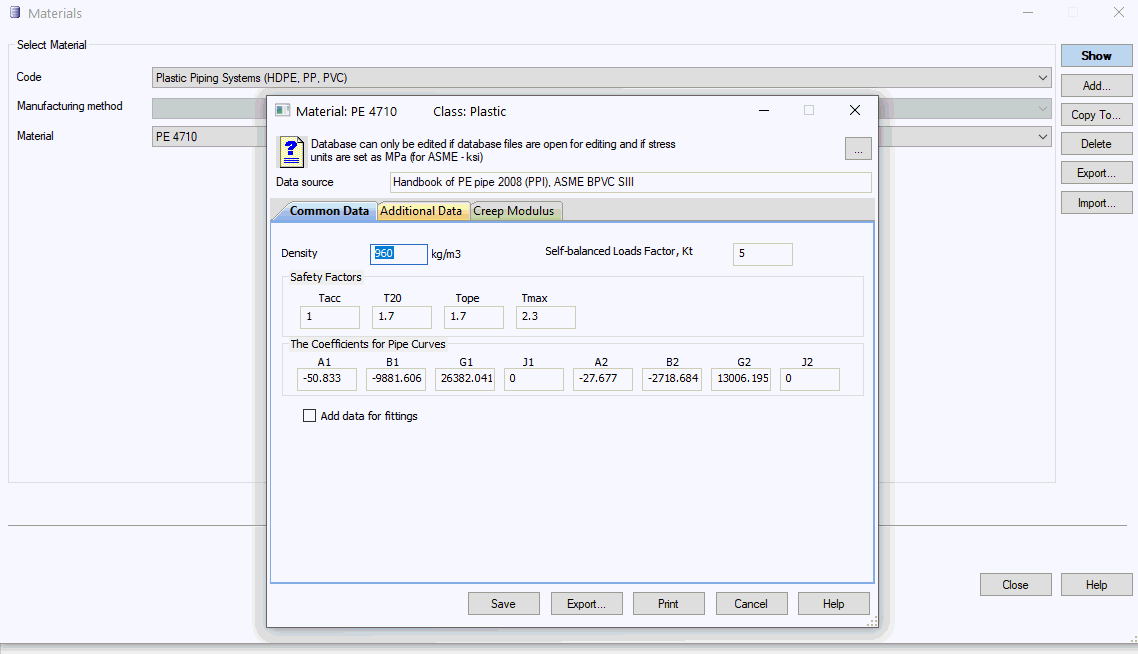

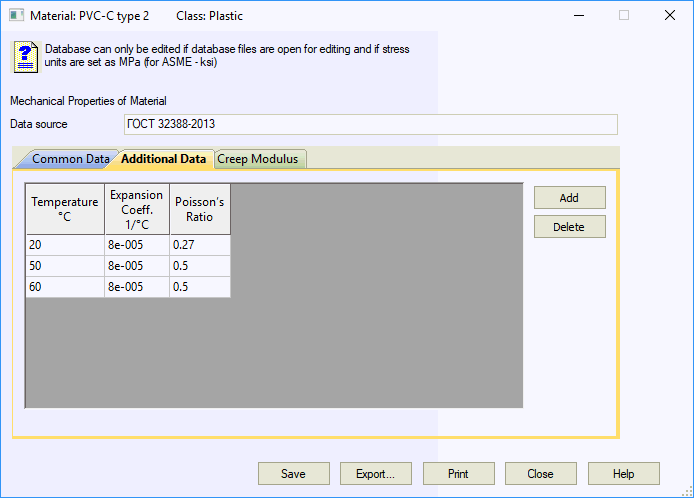
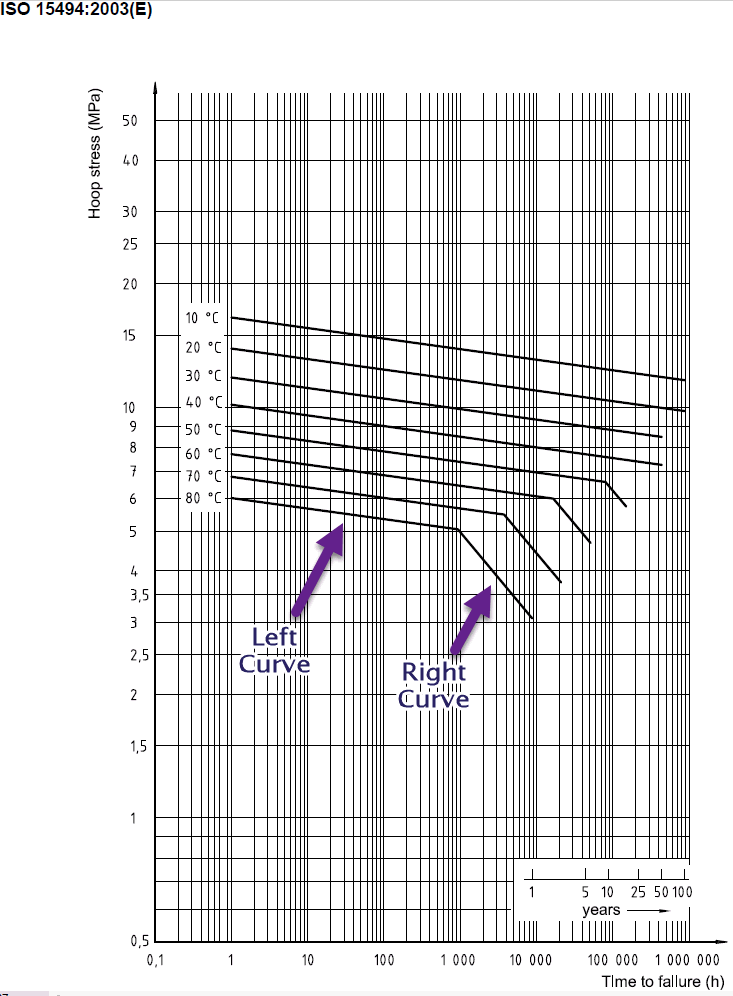
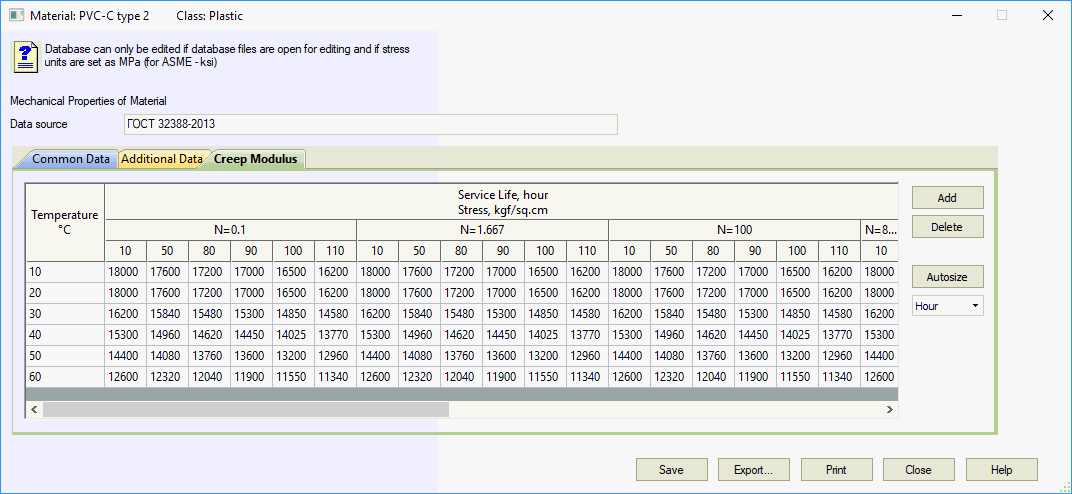
Service > Databases > Materials Library